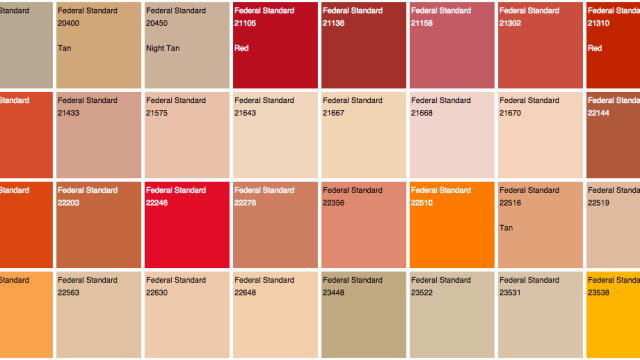What colour are the thousands of USPS mailboxes in your city? What about the millions of stop signs in the US? They’re all the same, but not by chance. In fact, figuring out those colours has been a 70-year process.
This week, the Washington Post published a quiz asking readers to identify the right hue for everything from highway signs to OSHA safety vests. Core77 pointed out that the answers were drawn from something called the Federal Standard 595C, a government-mandated list of 650 colours that dictate the colours of just about every object, building, vehicle, weapon, sign, or piece of infrastructure controlled by the Federal government.
There’s a red for Coast Guard bouys, #11350:

And a grey for NASA, #16473:

The Post office boxes and the Blue Angels share a shade, #15050:

So when did this system emerge? Who created it? And why?
The Colours of War
During World War II, the US government realised it needed to standardise the paint colours it used across both theatres. For example, the colour of fighter planes’ insignia became a serious liability: As the Navy changed the colours of its planes, it could be tough to tell an Allied plane from a Japanese one. “the red circle in the US national insignia was even more likely to be taken for the Japanese ‘meatball,’” explains Naval historian Tommy H. Thomason.
Plus, the US military was spread across an entire globe — making sure its equipment matched wasn’t just a safety issue, it was pretty much impossible in far-flung locales. “[The] problem of providing exact colour specification to an equipment subcontractor on the other side of the World became manifested itself with obvious clarity,” says ColorServer.
What could be done? The government began to create colour chips — each with an assigned number — to help contractors get the colours just right. And when the war ended, that system became law. The newly created General Services Administration created an index that would later become known as the Federal Standard 595C — a library colour samples that at first included just a few hundred colours, though today it includes 650.

So how did a project that began in the military get adopted by the entire Federal government? In 2011, the writer Graham T. Beck published a fantastic history of the project in The Morning News. In it, he explained how the post-War era, the development of the highway system and infrastructure necessitated a standard colour language. He also describes how the 595C isn’t foolproof:
In October 2001, F.S. No. 33696, a shade of yellow, was the colour of the 2,000-calorie plastic-wrapped food-aid packets that American forces dropped on Afghanistan. A very similar shade was used on the soft-drink-sized bomblets that the U.S. military also released from above. […] “Do not confuse the cylinder-shaped bomb with the rectangular food bag,” an American psy-ops radio broadcast reminded the local population.
It’s interesting to note that Federal Standard 595C was one of many other colour systems that sprang up around the same time. Pantone’s own index was developed in the early 1960s, spurred by similar issues but from the commercial printing and production world.
These systems were harbingers of modern globalisation: You only needed a colour index if you were dealing with producing many objects across many different locations and they all needed to look like the same product. In a weird way, paint has closely followed the progression of human civilisation — from the hand-mixed natural pigments of thousands of years ago, to the tightly-regulated chemical compositions that blanket our world today.
Go check out Beck’s great story from 2011 if you want to learn more about 595C.
